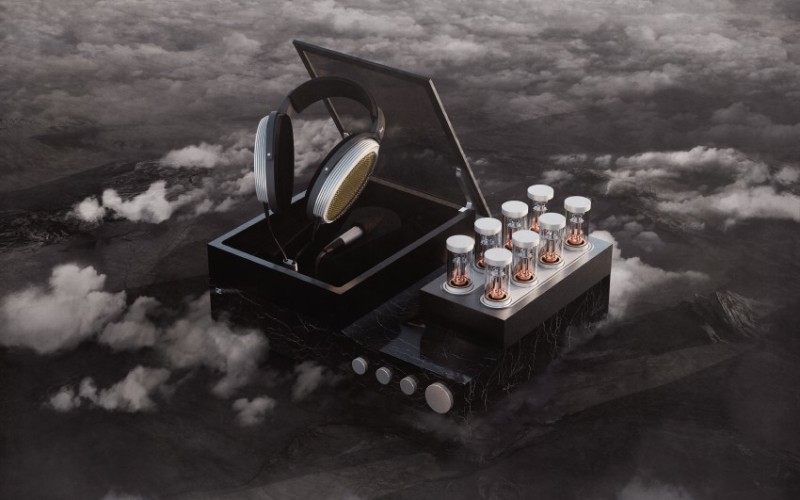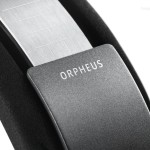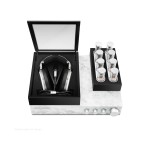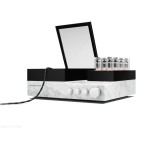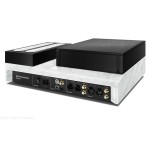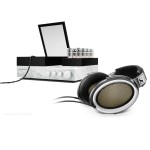Wedemark, 3 November 2015 – Audio specialist Sennheiser is re-defining the limits of audiophile sound. With the successor to the legendary Orpheus, and one that shares its famous name, Sennheiser is presenting a new reference headphone system that promises an unprecedented audio experience. This electrostatic headphone system combines a unique amplifier concept with carefully selected materials and highest quality craftsmanship. A frequency response that extends beyond the range of human hearing and the lowest total harmonic distortion that has ever been measured in an audio reproduction system are just some of the technical highlights of this milestone product. Sennheiser leaves no doubt that the exclusive Orpheus is the best headphone system in the world.
Building high-end headphones which sound so brilliant that you feel that you are in a concert hall; creating acoustics that surpass anything that has been heard before: this has always been Sennheiser’s vision. And in 1990/1991, the audio specialist achieved precisely that: Sennheiser took the audio world by storm with an engineering masterpiece that eliminated all previous ideas about the performance limitations of headphones. The Orpheus, an electrostatic headphone system with an impressive 500 V tube amplifier, became an icon of the audio industry and was recognized as the best headphones in the world – until now.
Almost 25 years after the legendary Orpheus, in the company’s 70th anniversary year, Sennheiser is once again surpassing the limits of what is technically feasible and is opening up a new chapter in audio excellence. The new Orpheus represents a unique combination of meticulous engineering skills and technological brilliance. The result: an unprecedented sound experience with the ultimate in reproduction precision and unique spatiality. “For seven decades now, Sennheiser has shaped the industry and has been at the cutting edge of audio by continuously re-defining the gold standard of what is technically possible,” said Sennheiser CEO Daniel Sennheiser. “With the Orpheus, we are once again pushing the boundaries and are showing that we can repeatedly set new benchmarks in excellence and reshape the future of the high-end audio world.”
In order to craft a successor to the legendary Orpheus as a reference product for the industry itself, Sennheiser worked tirelessly on innovative technical solutions, consistently putting previously used acoustics approaches to the test and exploiting every conceivable possibility when it came to selecting the optimum materials. For almost a decade, a core team of developers, engineers and designers dedicated themselves to producing a successor, and they have now created a headphone system that is beyond comparison. “We are very proud of this absolutely exceptional product,” said Sennheiser CEO Dr. Andreas Sennheiser. The Orpheus stands for the innovative capabilities of our company and the joint commitment of our workforce to the pursuit of perfect sound.”
A patented amplifier concept for incomparable sound
Reproducing sound that is as natural as possible and precise in every detail: with the new Orpheus, Sennheiser has come closer to this dream than anyone ever before. “No other sound reproduction system in the world is able to deceive our senses like the Orpheus. It creates the absolutely perfect illusion of being directly immersed in the sound,” said Daniel Sennheiser, describing the audio experience. To achieve this, the headphones use a completely new amplifier concept that combines the superior impulse processing of a tube amplifier with the low distortion of a transistor amplifier to perfection.
At the heart of the amplifier are eight vacuum tubes that process the incoming signal. “The advantage of tube amplifiers is their superior impulse processing,” said Axel Grell, Portfolio Manager Audiophile at Sennheiser. “However, one challenge is their sensitivity to air-borne-noise.” For this reason, the amplifier housing was crafted from granular, inhomogeneous Carrara marble and is freely suspended with the amplifier. The decoupling of the tubes in combination with the damping properties of the marble has the effect of reducing structure-borne noise to an absolute minimum. The tubes themselves also have a high-quality patent-pending enclosure consisting of quartz-glass bulbs that perfectly shield them from their surroundings.
The tube amplifier stage is followed by a patented ultra-high impulse amplifier stage that is directly integrated into the cups of the headphones. The result is impressive: a 200 percent rise in efficiency compared to other products. “In electrostatic headphones, most of the amplifier power is lost in the cable between the headphones and the tube amplifier. Only around one third of the power generated is actually used to produce sound waves,” explained Axel Grell. “Our approach was therefore to amplify the alternating voltage to high voltages not at the beginning of the cable but at the point where it is really required – directly at the gold-vaporised ceramic electrodes in the headphones themselves.” The great advantage of this design is the extremely short distance between the amplifier and the diaphragm, which is less than one centimeter in the new Orpheus. As a result, the headphone system requires far less power for charge reversal, as the current capacities are much lower. At a voltage of only around 5 Volt, the music signal is transmitted balanced to the high-voltage amplifier integrated into the headphones and is amplified there. This ensures extremely high impulse fidelity with relatively low power requirements. Just like the tubes of the tube amplifier, the system’s MOS-FET transistors have a square characteristic curve to prevent the hard distortion that occurs in amplifiers with bi-polar transistors.
Sennheiser places the new amplifier concept in a class that the audio specialist calls Cool Class A. In the low-frequency range, Cool Class A provides Class A power at any volume. In the high- and ultrahigh-frequency range, the amplifier switches from Class A to the usual Class AB operation. That will, however, only be the case when listening to a very unusual frequency spectrum. “Cool Class A is a brilliant idea: the music signal is reproduced without distortion and the headphones remain cool,” said Axel Grell. “We carried out extensive signal analyses and listening analyses as well as detailed tests to find out how much current we need at which frequency in order to achieve this unusual result.”
Gold-vaporised ceramic electrodes and platinum-vaporised diaphragms
Meticulous attention has also been paid to every detail of the material selection for the Orpheus in order to fully exploit the sound potential of the reference headphones. Each of the more than 6,000 individual components was carefully chosen, their acoustic characteristics were evaluated and finally the optimum combination was put together. After all, it is the interaction between all components that is ultimately responsible for the audio quality of the headphones. For example, to ensure the outstanding performance of the acoustic unit, Sennheiser uses gold-vaporised ceramic electrodes and platinum-vaporised diaphragms.
“When developing the electrodes, our aim was to find a material that is absolutely rigid in order to avoid the possible occurrence of distortion peaks at frequencies in the range of three to four kilohertz,” explained Axel Grell. Against this background, the engineers finally decided to use ceramic – a material whose internal damping and granular structure make it much more resistant to resonances than, for example, glass. However, producing such ceramic electrodes is a complex task: ceramics can neither be etched nor suitably drilled. For that reason, Sennheiser crafts the electrodes using a sophisticated spraying and grinding process. Subsequently, a layer of gold is vapor-deposited to guarantee optimum electrical conductivity.
Material selection and processing are also decisive when it comes to the coating for the diaphragm. After intensive tests, the choice was made in favor of a vapor-deposited coating of platinum. The thickness of the entire diaphragm is precisely 2.4 micrometres. With regard to the ratio of the diaphragm thickness to the coupled air mass, 2.4 micrometers was found to be the optimum for allowing controlled vibration of the diaphragm – the result of extensive testing by the team of developers. “In this case, it’s not a matter of 'the thinner, the better’ but of finding the absolute optimum,” said Axel Grell.
It goes without saying that the cables too have been specially designed and built. The eight wires of the high-performance cables are made of oxygen-free copper and plated with a coating of silver, which provides optimum conductivity for perfect transmission of the audio signal. The wires are sheathed in an insulating layer that has a mixture of differently structured materials which eliminates the sound waves acting on the cable.
Ultra-wide frequency response and the world`s lowest total harmonic distortion
With its unique transducer system, the new Orpheus has a frequency response of 8 hertz to more than 100 kilohertz. This is a frequency range which far exceeds the limits of human hearing ability. Nevertheless, this extremely wide frequency response does have an effect on the sound experience, as it ensures that, in the audible range, the sound of the headphones is virtually free of distortion.
At one kilohertz and a sound pressure level of 100 decibels, the total harmonic distortion of the headphone system is a mere 0.01 percent, which means it reproduces the sound of the audio source with greater fidelity and in more detail than any other product in the audio world. Therefore, in terms of sound purity, Sennheiser is venturing into areas that have never before been measured in a sound reproduction system. Even the slightest nuances of the music become audible. “In some music pieces that I had known for years, I suddenly became aware of details which I had never perceived before,” said Axel Grell, describing the listening experience with the new Orpheus. “I found this really moving – and every other listener will also be overwhelmed by this unique audio experience. After all, music is all about emotions.”
Technology beyond the reference
The Orpheus can be operated with a wide range of analogue and digital audio sources. Apart from balanced inputs, the headphone system also has unbalanced input sockets; the incoming signals are balanced before being further processed. Digital audio sources are connected via S/PDIF (optical and coaxial) or USB. To convert the digital music data into analoge signals, the Orpheus uses the ESS SABRE ES9018 chip – a reference in the field of digital-to-analoge converters. In the Orpheus, its eight internal DACs convert audio data with a resolution of 32 bits and a sampling rate of up to 384 kHz or DSD signals with 2.8 MHz and 5.6 MHz into balanced analoge signals. For each stereo channel, four DACs are connected in parallel for noise reduction. As a result, the entire frequency spectrum of high-end audio sources is reproduced without distortion. The circuit was optimised for the fully symmetrical design of the Orpheus.
Unrivalled sound experienced for all senses
The unique Orpheus experience begins long before you start listening. When the on/off-volume control is pressed, the controls at the front slowly extend from the amplifier housing, before the vacuum tubes with their quartz glass bulbs rise from the base and start to glow. Finally, a glass cover is automatically raised, allowing the headphones to be removed. “Our aim was to provide a sensual experience by using highest quality materials,” said Axel Grell.
The marble that Sennheiser chose for the amplifier housing comes from Carrara in Italy and is the same type of marble that Michelangelo used to create his sculptures. The rotary switches for the source and the volume controls are milled from a single piece of brass and chromium-plated. The positions of the four switches are controlled by a microprocessor and activated by high-quality relays. Each element can be remote-controlled and will follow any adjustments that the listener makes. For example, if the input switch is changed by remote control from USB to Balanced, the respective button will also rotate.
The combination of outstanding technology, exquisite design and the highest-quality materials is also continued in the headphones themselves. The genuine leather ear cushions are crafted in Germany and ensure the highest possible comfort even over several hours. At the inner side of the cushions, hypoallergenic, breathable microfiber fabric provides additional acoustic absorption. All these materials form an ingenious combination of design, comfort and function – for a unique audio experience that appeals to all senses.
The Orpheus was developed at Sennheiser’s headquarters in Germany. The new reference product will also be manufactured there. The Orpheus will be available from mid-2016 and will cost around € 50,000.
To immerse yourself in the unique world of the Orpheus, please visit www.sennheiser-reshapingexcellence.com
About Sennheiser
Audio specialist Sennheiser is one of the world’s leading manufacturers of headphones, microphones and wireless transmission systems. Based in Wedemark near Hanover, Germany, Sennheiser operates its own production facilities in Germany, Ireland and the USA and is active in more than 50 countries. With 18 sales subsidiaries and long-established trading partners, the company supplies innovative products and cutting-edge audio solutions that are optimally tailored to its customers’ needs. Sennheiser is a family-owned company that was founded in 1945 and which today has 2,700 employees around the world that share a passion for audio technology. In 2014, the Sennheiser Group had sales totalling €635 million.


